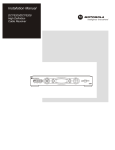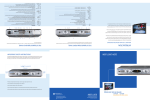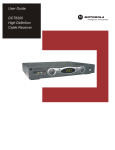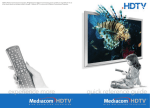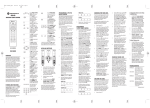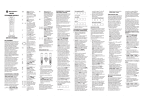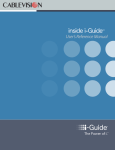Download Seaside Communications DCT 6208 User manual
Transcript
SEASIDE TV DCT 6208 HD DVR Wiring Instructions Additional Information Digital Cable Box USER MANUAL DVR/HDTV Capable CAUTION RISK OF ELECTRIC SHOCK DO NOT OPEN CAUTION: TO REDUCE THE RISK OF ELECTRIC SHOCK, DO NOT REMOVE COVER (OR BACK). NO USER-SERVICEABLE PARTS INSIDE. REFER SERVICING TO QUALIFIED SERVICE PERSONNEL. Graphical Symbols and supplemental warning marking locations on bottom of terminal. WARNING TO REDUCE THE RISK OF FIRE OR SHOCK, DO NOT EXPOSE THIS APPLIANCE TO RAIN OR MOISTURE. CAUTION TO PREVENT ELECTRICAL SHOCK, DO NOT USE THIS (POLARIZED) PLUG WITH AN EXTENSION CORD, RECEPTACLE, OR OTHER OUTLET UNLESS THE BLADES CAN BE FULLY INSERTED TO PREVENT BLADE EXPOSURE. The lightning flash with arrowhead symbol, within an equilateral triangle, is intended to alert the user to the presence of uninsulated “dangerous voltage” within the product’s enclosure that may be of sufficient magnitude to constitute a risk of electric shock to persons. The exclamation point, within an equilateral triangle, is intended to alert the user to the presence of important operating and maintenance (servicing) instructions in the literature accompanying the appliance. IMPORTANT SAFETY INSTRUCTIONS 1 Read instructions All the safety and operating instructions should be read before the digital cable box is operated. 2 Retain instructions The safety and operating instructions should be retained for future reference. 3 Heed warnings All warnings on the digital cable box and in the operating instructions should be adhered to. 4 Follow instructions All operating and use instructions should be followed. 5 Cleaning Unplug this product from the wall outlet before cleaning. Do not use liquid cleaners or ae rosol cleaners. Use a damp cloth for cleaning. 6 Attachments Do not use attachments not recommended as they may cause hazard. 7 Water and moisture Do not use this equipment near water; for example, near a bathtub, wash bowl, kitchen sink, or laundry- tub, in a wet basement, or near a swimming pool, and the like. 8 Accessories Do not place this product on an unstable cart, stand, tripod, bracket, or table. The product may fall causing serious injury and serious damage to the appliance. Use only with a cart, stand, tripod, bracket, or table recommended by the manufacturer, or sold with the equipment. Any mounting of the appliance should follow the manufacturer’s instructions, and should use a mounting accessory recommended by the manufacturer. 9 Ventilation Slots and openings in the cabinet are provided for ventilation and to ensure reliable operation of the equipment and to protect it from overheating. The openings should never be blocked by placing the product on a bed, sofa, rug, or similar surface. Equipment should never be placed near or over a radiator or heat register, or in a built- in installation such as a bookcase or rack unless proper ventilation is provided. 10 Power sources This product should be operated only from the type of power sources indicated on the mar king label. If you are not sure of the type of power supplied to your home, consult your local power company. For equipment intended to operate from battery power, or other sources, refer to the operating instructions. 11 Ground or polarization This equipment may be equipped with a polarized alternating - current line plug (a plug having one blade wider than the other). This plug will fit into the power outlet only one way. This is a safety feature. If you are unable to insert the plug fully into the outlet, try reversing the plug. If the plug should still fail to fit, contact your electrician to replace your obsolete outlet. Do not defeat the safety purpose of the polarized plug. 12 Alternate warnings This equipment may be equipped with a 3 - wire grounding - type plug , a plug having a third (grounding) pin. This pin will only fit into a grounding - type power outlet. This is a safety feature. If you are unable to insert the plug into the outlet, contact your electrician to replace your obsolete outlet. Do not defeat the safety purpose of the grounding - type plug. 13 Power cord protection Power supply cords should be routed so that they are not likely to be walked on or pinched by items placed upon or against them, paying particular attention to cords at plugs, convenience receptacles, and the point where they exit from the appliance. IMPORTANT SAFETY INSTRUCTIONS 14 Outdoor Cable Grounding Ensure the cable system is grounded as to provide some protection against voltage surges and built-up static charges. 15 Lightning For added protection for this equipment during a lightning storm, or when it is left unattended and unused for long periods of time, unplug it from the wall outlet and disconnect the cable system. This will prevent damage to the video product due to lightning and power line surges. 16 Overloading Do not overload wall outlets and extension cords as this can result in a risk of fire or electrical shock. 17 Object and liquid entry Never push objects of any kind into this equipment through openings, as they may touch dangerous voltage points or short - out parts that could result in a fire or electrical shock. Never spill liquid of any kind on the product. 18 Servicing Do not attempt to service this equipment yourself, as opening or removing covers may expose you to dangerous voltage or other hazards, return to Seaside Communications for replacement. 19 Safety check Upon completion of any service to this digital cable box, ask the Seaside service technician to perform safety checks to determine that the product is in proper operational condition. 20 Heat This digital cable box should be situated away from heat sources such as radiators, heat registers, stoves, or other products (including amplifiers) that produce heat. CANADIAN COMPLIANCE This Class B digital apparatus meets all requirements of the Canadian Interference - Causing Equipment Regulations. Cet appareil numérique de la classe B respects toutes les exigences du Règlement sur le matériel brouilleur du Canada. www.ic.gc.ca/eic/site/ic1.nsf/eng/home www.ic.gc.ca/eic/site/ic1.nsf/fra/accueil Disclaimer The information in this document is carefully examined, and is believed to be entirely reliable. However, no responsibility is assumed for inaccuracies. Furthermore, Seaside Communications reserves the right to make changes herein to improve readability, function, or design. Motorola Computer Software Copyrights The Motorola product described in this manual may include copyrighted Motorola computer programs stored in semiconductor memories or other media. Laws in the United States and other countries preserve for Motorola certain exclusive rights for copyrighted computer programs, including, but not limited to, the exclusive right to copy or reproduce in any form the copyrighted computer program. Accordingly, any copyrighted Motorola computer programs contained in the Motorola products described in this manual may not be copied, reproduced, modified, reverse-engineered, or distributed in any manner without the express written permission of Motorola. Furthermore, the purchase of Motorola products shall not be deemed to grant either directly or by implication, estoppel, or otherwise, any license under the copyrights, patents or patent applications of Motorola, except for the normal non-exclusive license to use that arises by operation of law in the sale of a product. Motorola, Inc. www.motorola.com MOTOROLA and the Stylized M Logo are registered in the U.S. Patent and Trademark Office. All other product or service names are the property of their respective owners. © Motorola, Inc. 2010 DCT 6208 User Guide CONTENTS Introduction ............................................................................................. 3 Basic Operation....................................................................................... 6 Turning Power On and Off............................................................... 6 Changing Channels .......................................................................... 6 Adjusting the Volume....................................................................... 6 Interactive Program Guide............................................................... 6 Audio/Video Connections ...................................................................... 7 RF Bypass................................................................................................ 8 Optimizing Your DCT* Output Settings .............................................. 10 User Options ................................................................................... 12 Connecting Your DCT* ......................................................................... 15 Connecting Your DCT* to a HDTV – Video Only ................................ 16 Connecting Your DCT* to a HDTV – Audio Only................................ 18 Connecting Your DCT* to an A/V Receiver – Audio Only ................. 20 Connecting your DCT* to a Stereo TV ................................................ 22 Connecting your DCT* to a Stereo TV and Stereo VCR .................... 24 Connecting your DCT* to an A/V Receiver, TV, and VCR ................. 26 Connecting your DCT* to a Stereo TV, VCR, and DVD...................... 28 Recording Your Connections .............................................................. 30 Graphics Overlaying the Video............................................................ 32 1 DCT 6208 User Guide CONTENTS Data Devices..........................................................................................33 Data Features..................................................................................34 Troubleshooting....................................................................................35 Specifications........................................................................................40 Physical Dimensions......................................................................40 2 DCT 6208 User Guide INTRODUCTION Welcome and congratulations on receiving a Motorola DCT* High Definition Cable Receiver, one of the most advanced interactive digital cable receivers available today. With the DCT*, Motorola has merged the extraordinary features of digital cable - the seemingly endless programming options, interactive program guides, Video on Demand (VOD), and commercial free, CD quality music – with digital video recording (DVR) and the incredible picture quality and sound of High-Definition TV. The DCT 6208 is the next generation of Motorola’s DCT5100 platform enhanced with an internal processor. The DCT6208 also includes an “Entertainment Package” that enables a direct digital connection to consumer audio and video devices via 1394-DTV and DVI interfaces. The DCT6208 is fully equipped with an integrated 80 GB hard drive for hours of DVR functionality, including the capability of recording high definition programs. The DCT6208 also features a 1394 Firewire digital interface to enable external hard-drive expansion for increased storage or connection to future networked video devices. This User Guide introduces you to the basic features of the DCT*, outlines important safeguards, and provides several options for integrating this component into your current entertainment system. Please take a few moments to read through this User Guide as the configuration diagrams, on - screen menu description, and troubleshooting section will help you make the most of your home entertainment experience. 3 DCT 6208 User Guide Message Indicator Lights when a message is waiting POWER switch FRONT PANEL Turns the DCT* on or off MENU switch Displays the menu area INFO switch Displays current channel and program information CURSOR INFO MSGS. MENU ON MU TE POWER USB VIDEO IN L AUDIO IN R CURSOR POWER indicator Moves cursor around program guide and menu screens Lights to indicate DCT* is on AUDIO IN (L/R)* Connects to a CD player or stereo tuner USB* Connects to support devices VIDEO IN* Connects to baseband video output of a VCR, camcorder, or other video device TO TV/VCR Connects to TV or VCR CABLE IN Connects to cable signal from your service provider AUDIO IN (R/L)* Connects to a CD player or stereo tuner ETHERNET* DVI* Supports PC networking Connects DCT* to a high-definition TV ETHERNET TO TV/VCR R AUDIO IN DVI-D OUT IR CABLE IN AUDIO OUT USB TV Pass Card IR Enables DCT* to control a VCR while recording a selected program. (Not supported by all program guides). USB* Connects to support devices AUDIO OUT (R/L) Connects to audio input of a stereo receiver 4 L DCT6200/DCT6208 User Guide A/B Indicator Lights, if optional switch is activated SELECT switch Selects menu options GUIDE switch Displays the program guide A/B switch Manually enables RF bypass function (optional) CH ANNEL A/B P A/B GUIDE SMART C ARD REMOTE SELEC T REMOTE indicator SMART CARD* Lights to indicate remote control is in use Supports electronic commerce using a Smart Card. Display CHANNEL Displays channel number and time of day Scrolls down or up through the channels SPDIF Provides Dolby® Digital 5.1 audio or PCM audio VIDEO IN* BACK PANEL Connects to baseband video output from a VCR, camcorder, or other video device VIDEO OUT Delivers video to an external device, such as a TV or VCR L SPDIF IN VIDEO OUT IEEE 1394 S-VIDEO Y AC Switched Outlet Connect AC power cord from another device, such as a TV or VCR Pb Pr OPTICAL SPDIF IEEE 1394 Connects to audio and video devices Y Pb Pr Delivers component video OPTICAL SPDIF Provides Dolby® Digital 5.1 audio or PCM audio S-Video Connect to S-Video input of TV or VCR *Your DCT6200/DCT6208 may not support all of the inputs and outputs shown. 5 BASIC OPERATION Turning Power On and Off Press POWER on the front panel to turn the DCT* on or off. When using the remote control, be sure it is in cable mode by pressing CABLE before pressing POWER. Changing Channels You can change channels in two ways: • Press CHANNEL or on the front panel of the DCT*, or press CHANNEL + or - on the remote control to step through the channel selection. • Enter the number of the channel you want to tune using the number keys on the remote control. Adjusting the Volume Press VOLUME + or – on the remote control to adjust the volume. When you adjust the volume, the volume scale is displayed on the screen. Press MUTE on the remote control to turn the sound off and on again. For best audio quality, use the remote control to set the DCT* to approximately ¾ of the maximum volume level and then adjust the audio levels on external devices such as your TV or A/V Receiver. Interactive Program Guide The interactive program guide displays information about TV programs and enables you to access features such as Parental Control or Pay-Per-View. Interactive program guides can vary with each cable service provider. Refer to the interactive program guide instruction manual for detailed instructions. 6 DCT6200/DCT6208 User Guide AUDIO/VIDEO CONNECTIONS Before you move or change components on your entertainment system, review the following: • For basic cable connections, use 75-ohm coaxial cables equipped with F-type connectors. A 6-foot coaxial cable is provided to connect the DCT* to your cable wall outlet. A 6-foot component video cable and left/right audio cables are also provided to connect the DCT* to your TV. • If your equipment supports it, S-video connections may be used in place of the standard RCA video connections. In most cases, S-video offers a higher level of standard definition video quality than RCA video • If your equipment supports it, the optical (OPTICAL SPDIF) or coaxial digital (SPDIF) audio outputs may be used in place of the stereo audio outputs (AUDIO R and L). In most cases these outputs offer a higher level of audio quality, including support for 5.1 Surround Sound. • If you are connecting a coaxial cable from the TO TV/VCR connector on the DCT* to the coaxial CABLE/ANTENNA IN connector on the TV, you must tune your TV to channel 3 or 4 to view the DCT* output. Connecting the DCT* in this manner will remove its high definition video capability. • Disconnect power from the DCT* before connecting or changing cable connections. The DCT* offers Component and DVI video outputs. These outputs provide a high level of video quality. If your High Definition television (HDTV) or home theater receiver supports either of these connections, use one or the other instead of the RCA type or S-Video connections. For more information on connecting High Definition video, see “Connecting your DCT* to an HDTV – Video Only” on page 16. CAUTION! Do not place anything on top of the DCT*, especially other home entertainment components. Be sure to provide adequate ventilation to prevent overheating. 7 RF BYPASS oc=ETR=çÜãF ÅçååÉÅíáçå a`qSOMMLa`qSOMU ETHERNET TO TV/VCR R AUDIO IN L SPDIF VIDEO IN OUT RPT OUT DVI-D OUT IR RF IN AUDIO OUT USB IEEE 1394 S-VIDEO RF IN Y Pb Pr TV Pass Card OPTICAL SPDIF RF OUT CONV OUT CONV IN CABLE IN TO TV/VCR CABLE IN From cable outlet To TV 8 DCT6200/DCT6208 User Guide The DCT* may be equipped with an optional RF Bypass switch. When the optional RF bypass switch is activated, it routes the cable signal directly to a cable-ready TV, bypassing the DCT*. This configuration enables you to view clear (unscrambled) analog programming on the direct cable signal should the DCT* be powered off. The RF bypass is not available on all cable systems. 9 OPTIMIZING YOUR DCT* OUTPUT SETTINGS The Motorola DCT* delivers high-quality video for high definition TVs using the YPbPr (component) and DVI-D video connectors. This section describes how to use the on-screen display to set your DCT* to automatically optimize both standard and high definition video based on your HDTV and personal preferences. You can use your on-screen menu to configure your high definition settings for TV type, DVI and/or YPbPr video output and closed captioning. To access your high definition settings, ensure that your DCT* is plugged into a power outlet and is turned off. Press the MENU key on the front panel. If your TV is on, the on-screen display menu appears listing the settings you can configure. DVI/YPbPr OUTPUT Use your remote control or the cursor keys on the front panel to navigate the on-screen display. Press the ▲ and ▼ keys to highlight the setting you wish to change. Press the ► key to select an option for that setting. To exit the setting and move to another setting, use the ▲ and ▼ keys. To exit the menu and save your settings, press the POWER or MENU key. The high definition settings are described in the table on the following pages. 10 DCT6200/DCT6208 User Guide The DVI/YPbPr OUTPUT setting displays as YPbPr OUTPUT if you are not using the DVI video connection. The user settings will also be displayed on the front panel LED whether your TV is off or on. If the on-screen display menu does not appear on your HDTV screen, your TV may not support the default video output setting. Use the DCT* front panel LED to view and change your settings. 11 User Options Setting Description TV Type Selects the type of TV. The LED panel will display the output type you have selected. Defaults to 16:9. Options are 16:9 (for wide screen TVs); 4:3 LETTERBOX or 4:3 PAN/SCAN (for normal TVs). 4:3 LETTERBOX allows you to view widescreen programming in a letterbox format through the S-video, composite video, or RF video outputs when the DCT* is tuned to a widescreen program. 4:3 PAN/SCAN allows you to view widescreen programming in 4:3 full screen format through the S-video, composite video, or RF video outputs when the DCT* is tuned to a widescreen program. Y Pb Pr Output Selects the video display for the DVI and YPbPr component video outputs. The LED panel will display the format you have selected. Defaults to 1080i. Options are 1080i, 720p, 480p, or 480i. Some TVs can only support certain display formats. Check your TV User Guide for more information. If you are not using an HDTV, selecting a format other than 480i will cause the on-screen display to go blank. If this happens you can still view your settings on the LED panel to change the format back to 480i. 12 DCT6200/DCT6208 User Guide Setting Description 4:3 Override Selects the DVI or YPbPr (Component video) output format of the DCT* when it is tuned to 4:3 standard definition programs. Defaults to 480i. Options are OFF, 480i or 480p. If the DVI/YPbPr Output is set to 480i, this setting becomes redundant and defaults to OFF. This setting provides the ability to specify how 4:3 pictures are to be displayed on your TV. Most TV programming is 4:3 aspect ratio (square). Selecting OFF will display regular TV programs that are 4:3 aspect ratio in widescreen format. If you have a widescreen TV, black bars will be placed on the left and right of the picture to fit your screen. Selecting OFF when you have a 4:3 TV Type may result in a small picture with black bars on all four sides of the screen. Selecting 480i will transmit TV programs that are not high definition in their original 480i format. Some TVs cannot display 480i format on their component video inputs (Y Pb Pr). Check your TV User Guide for more information. Selecting 480p will convert TV programs that are not high definition to a higher quality 480p format. Some TVs cannot display 480p format on their component video inputs (Y Pb Pr). Check your TV User Guide for more information. Closed Caption Turns closed captions off or on. The LED panel will display the status of the closed captions. Defaults to DISABLED. Options are ENABLED or DISABLED. Pen Size Selects the font size for closed captions. Defaults to AUTO. Options are AUTO, STANDARD, LARGE, or SMALL. Font Style Selects the font style for closed captions. Defaults to AUTO. Options are AUTO, MONO SERIF, PROPORTION SERIF, MONO NO SERIF, PROPORTION NO SERIF, CASUAL, CURSIVE, or SMALL. Foreground Color Selects the foreground color for closed captions. Defaults to AUTO. Foreground Opacity Selects the opacity of the closed captions foreground. Defaults to AUTO. Options are AUTO, WHITE, BLACK, RED, GREEN, BLUE, YELLOW, MAGENTA, or CYAN. Options are AUTO, TRANSPARENT, TRANSLUCENT, SOLID, or FLASHING. 13 Setting Description Background Color Selects the background color for closed captions. Defaults to AUTO. Background Opacity Selects the background opacity for closed captions. Defaults to AUTO. Service Selection Selects the service to be used for closed captions. Defaults to AUTO. Options are AUTO, WHITE, BLACK, RED, GREEN, BLUE, YELLOW, MAGENTA, or CYAN. Options are AUTO, TRANSPARENT, TRANSLUCENT, SOLID, or FLASHING. Options are AUTO, PRIMARY LANGUAGE, SECONDARY LANGUAGE, 3, 4, 5, or 6. Settings Selects the default settings for closed captions (AUTO) or the settings you have configured (USER). Defaults to AUTO. Options are AUTO or USER. Restore Defaults Resets the on-screen display options to their default settings. 14 DCT6200/DCT6208 User Guide CONNECTING YOUR DCT* This section describes how to connect the DCT* to your home entertainment system. Instructions and diagrams are included for the following connections to the DCT*: • High Definition Television (HDTV) • A/V Receiver – Audio • Stereo TV • Stereo TV and Stereo VCR • A/V Receiver, TV, and VCR • Stereo TV, VCR, and DVD In this User Guide, DCT* refers to both the DCT6200 and DCT6208 High Definition Cable Receivers. 15 CONNECTING YOUR DCT* TO A HDTV – VIDEO ONLY asf ÅçååÉÅíáçå `çãéçåÉåí=îáÇÉç ÅçååÉÅíáçå a`qSOMMLa`qSOMU ETHERNET TO TV/VCR R AUDIO IN IEEE 1394 S-VIDEO AUDIO OUT TV Pass Card USB Y Pb Pr OPTICAL SPDIF `~ÄäÉ= áå báíÜÉê=L=çê eaqs Component Video Input CABLE/ ANTENNA IN VIDEO IN OUT DVI-D OUT IR CABLE IN DVI-HDTV L SPDIF Y Pb Pr 16 DCT6200/DCT6208 User Guide Connecting HDTV – Video Only 1 Connect an RF coaxial cable to the cable wall outlet and the CABLE IN connector on the DCT*. 2 Connect the component video cables to the Y, Pb, and Pr connectors on your HDTV and DCT*. Or Connect a DVI cable to the DVI-D OUT connector on the DCT* and the DVI-HDTV connector on your TV. These connections support only the high-definition video connection between the DCT* and the HDTV. To connect the audio connections for your HDTV, proceed to the following page. To connect your audio connections for an A/V receiver, go to “Connecting Your DCT* to an A/V Receiver – Audio Only”. For information on configuring your DCT* settings, see “Optimizing Your DCT* Output Settings”. 17 CONNECTING YOUR DCT* TO A HDTV – AUDIO ONLY ^ìÇáç ÅçååÉÅíáçå a`qSOMMLa`qSOMU ETHERNET TO TV/VCR R AUDIO IN L SPDIF DVI-D OUT IR CABLE IN IEEE 1394 S-VIDEO AUDIO OUT Y TV Pass Card USB Pb Pr OPTICAL SPDIF eaqs INPUT S-VIDEO VIDEO CABLE/ ANTENNA IN VIDEO IN OUT AUDIO LEFT AUDIO RIGHT 18 DCT6200/DCT6208 User Guide Connecting HDTV – Audio Only • Connect the stereo audio cable to the AUDIO R and L connectors on the DCT* and the AUDIO LEFT and AUDIO RIGHT connectors on the HDTV. For information on configuring your DCT* settings, see “Optimizing Your DCT* Output Settings”. 19 CONNECTING YOUR DCT* TO AN A/V RECEIVER – AUDIO ONLY ^ìÇáç ÅçååÉÅíáçå aáÖáí~ä=~ìÇáç ÅçååÉÅíáçå léíáÅ~ä ÅçååÉÅíáçå a`qSOMMLa`qSOMU ETHERNET TO TV/VCR R AUDIO IN L SPDIF VIDEO IN OUT DVI-D OUT IR CABLE IN Y Pb Pr TV Pass Card OPTICAL SPDIF báíÜÉê=L=çê R AUDIO L VIDEO VIDEO S-VIDEO DIGITAL INPUT COAX DVD CABLE/TV OPTICAL VIDEO 2 TV/MONITOR OUTPUT SPEAKER CONNECTORS IN VIDEO S-VIDEO VCR IEEE 1394 S-VIDEO AUDIO OUT USB OUT ^Ls=êÉÅÉáîÉê 20 DCT6200/DCT6208 User Guide Connecting an A/V Receiver – Audio Only There are three options available for audio connections to your A/V receiver: • Optical (OPTICAL SPDIF) • Coaxial (SPDIF) • Stereo audio (AUDIO R and L) If your equipment supports it, the optical (OPTICAL SPDIF) or coaxial (SPDIF) audio outputs may be used in place of the stereo audio outputs (AUDIO R and L). In most cases these outputs offer a higher level of audio quality, including support for 5.1 surround sound. • Optical SPDIF: Connect the optical SPDIF cable to the OPTICAL on the DCT* and the OPTICAL connector on the A/V receiver. SPDIF connector • SPDIF: Connect the digital audio cable to the SPDIF connector on the DCT* and the DIGITAL INPUT COAX connector on the A/V receiver. • Stereo audio: Connect the stereo audio cable to the AUDIO R and L connectors on the DCT* and the AUDIO LEFT and AUDIO RIGHT connectors on the A/V receiver. For information on configuring your DCT* settings, see “Optimizing Your DCT* Output Settings”. 21 CONNECTING YOUR DCT* TO A STEREO TV oc=ETR=çÜãF ÅçååÉÅíáçå pJsáÇÉç =ÅçååÉÅíáçå sáÇÉç ÅçååÉÅíáçå ^ìÇáç ÅçååÉÅíáçå a`qSOMMLa`qSOMU ETHERNET TO TV/VCR R AUDIO IN L SPDIF VIDEO IN OUT DVI-D OUT IR CABLE IN USB IEEE 1394 S-VIDEO AUDIO OUT TV Pass Card Y Pb Pr OPTICAL SPDIF `~ÄäÉ= áå báíÜÉê=L=çê píÉêÉç=qs báíÜÉê=L=çê INPUT S-VIDEO VIDEO CABLE/ ANTENNA IN AUDIO LEFT AUDIO RIGHT 22 DCT6200/DCT6208 User Guide Connecting a Stereo TV 1 Connect an RF coaxial cable to the cable wall outlet and the CABLE IN connector on the DCT*. 2 Connect a second RF coaxial cable to the TO TV/VCR connector on the DCT* and the CABLE/ANTENNA IN connector on the TV. Or Connect the stereo audio cable to the AUDIO R and L connectors on the DCT* and the AUDIO LEFT and AUDIO RIGHT connectors on the stereo TV. Connect a video cable to the VIDEO OUT connector on the DCT* and the INPUT VIDEO on the TV or an S-video cable to the S-VIDEO connectors on the DCT* and the TV. This video connection method does not support High Definition video. For more information, see “Connecting your DCT* to an HDTV – Video Only” on page 16. 23 CONNECTING YOUR DCT* TO A STEREO TV AND STEREO VCR oc=ETR=çÜãF ÅçååÉÅíáçå sáÇÉç ÅçååÉÅíáçå ^ìÇáç ÅçååÉÅíáçå a`qSOMMLa`qSOMU ETHERNET TO TV/VCR R AUDIO IN L SPDIF IN VIDEO OUT DVI-D OUT IR CABLE IN USB IEEE 1394 S-VIDEO AUDIO OUT Y Pb Pr TV Pass Card OPTICAL SPDIF `~ÄäÉ=áå píÉêÉç=s`o píÉêÉç=qs INPUT INPUT CABLE/ ANTENNA IN To TV AUDIO R VIDEO L S-VIDEO OUTPUT AUDIO R VIDEO VIDEO CABLE/ ANTENNA IN L AUDIO LEFT AUDIO RIGHT 24 DCT6200/DCT6208 User Guide Connecting a Stereo TV and Stereo VCR 1 Connect an RF coaxial cable to the cable wall outlet and the CABLE IN connector on the DCT*. 2 Connect a stereo audio cable to the AUDIO OUT R and L connectors on the DCT* and the INPUT AUDIO R and L connectors on the stereo VCR. 3 Connect a video cable to the VIDEO OUT connector on the DCT* and the INPUT VIDEO connector on the stereo VCR. 4 Connect a stereo audio cable to the OUTPUT AUDIO R and L connectors on the Stereo VCR and the INPUT AUDIO RIGHT and LEFT connectors on the stereo TV. 5 Connect a video cable to the OUTPUT VIDEO connector on the stereo VCR and the INPUT VIDEO connector on the stereo TV. The video connection method does not support high definition video. For more information, see “Connecting your DCT* to an HDTV – Video Only” on page 16. 25 CONNECTING YOUR DCT* TO AN A/V RECEIVER, TV, AND VCR oc=ETR=çÜãF ÅçååÉÅíáçå sáÇÉç ÅçååÉÅíáçå ^ìÇáç ÅçååÉÅíáçå aáÖáí~ä=~ìÇáç ÅçååÉÅíáçå léíáÅ~ä ÅçååÉÅíáçå a`qSOMMLa`qSOMU ETHERNET TO TV/VCR R VIDEO IN OUT L SPDIF AUDIO IN DVI-D OUT IR CABLE IN IEEE 1394 S-VIDEO AUDIO OUT Pb Y Pr TV Pass Card USB OPTICAL SPDIF `~ÄäÉ= áå píÉêÉç=s`o píÉêÉç=qs INPUT INPUT CABLE/ ANTENNA IN To TV AUDIO R VIDEO L S-VIDEO OUTPUT AUDIO R VIDEO VIDEO AUDIO LEFT CABLE/ ANTENNA IN L AUDIO RIGHT ^Ls=êÉÅÉáîÉê R AUDIO L VIDEO VIDEO S-VIDEO DIGITAL INPUT COAX DVD OPTICAL CABLE/TV VIDEO 2 TV/MONITOR OUTPUT IN VCR VIDEO S-VIDEO OUT 26 SPEAKER CONNECTORS DCT6200/DCT6208 User Guide Connecting an A/V Receiver, TV, and VCR 1 Connect an RF coaxial cable to the cable wall outlet and the CABLE IN connector on the DCT*. 2 Connect a stereo audio cable to the AUDIO OUT R and L connectors on the DCT* and the INPUT R and L connectors on the A/V receiver. 3 Connect a video cable to the VIDEO OUT connector on the DCT* and the CABLE/TV VIDEO connector on the A/V receiver. 4 Connect a stereo audio cable to the VCR AUDIO OUT R and L connectors on the A/V receiver and the INPUT AUDIO R and L connectors on the stereo VCR. 5 Connect a stereo audio cable to the OUTPUT AUDIO OUT R and L connectors on the stereo VCR and the VCR AUDIO IN R and L connectors on the A/V receiver. 6 Connect a video cable to the INPUT VIDEO connector on the stereo VCR and the VIDEO VCR OUT connector on the A/V receiver. 7 Connect a video cable to the OUTPUT VIDEO connector on the stereo VCR and the VIDEO VCR IN connector on the A/V receiver. 8 Connect a video cable to the INPUT VIDEO connector on the stereo TV and the TV/MONITOR OUTPUT video connector on the A/V receiver. If your equipment supports it, the optical (OPTICAL SPDIF) or coaxial (SPDIF) audio outputs may be used in place of the stereo audio outputs (AUDIO R and L). In most cases these outputs offer a higher level of audio quality, including support for 5.1 surround sound. If your equipment supports it, S-video connections may be used in place of the standard RCA video connections. In most cases, S-video offers a higher level of standard definition video quality than RCA video. The optional connections marked with an * allow you to use the DCT* and TV without powering-on the VCR and A/V Receiver: • Connect an RF coaxial cable to the TO TV/VCR connector on the DCT* and the CABLE/ANTENNA IN connector on the stereo VCR. • Connect an RF coaxial cable to the TO TV connector on the stereo VCR and the CABLE/ANTENNA IN connector on the stereo TV. The video connection method does not support high definition video. For more information, see “Connecting your DCT* to an HDTV – Video Only” on page 16. 27 CONNECTING YOUR DCT* TO A STEREO TV, VCR, AND DVD oc=ETR=çÜãF ÅçååÉÅíáçå pJsáÇÉç =ÅçååÉÅíáçå sáÇÉç ÅçååÉÅíáçå ^ìÇáç ÅçååÉÅíáçå a`qSOMMLa`qSOMU ETHERNET TO TV/VCR R AUDIO IN L SPDIF VIDEO IN OUT DVI-D OUT IR CABLE IN USB IEEE 1394 S-VIDEO AUDIO OUT TV Pass Card Y Pr Pb OPTICAL SPDIF `~ÄäÉ= áå s`o píÉêÉç=qs INPUT INPUT CABLE/ ANTENNA IN AUDIO To TV R VIDEO L S-VIDEO OUTPUT AUDIO R VIDEO L VIDEO AUDIO LEFT CABLE/ ANTENNA IN AUDIO RIGHT asa AUDIO OUT COAX OPTICAL DIGITAL R VIDEO OUT L ANALOG báíÜÉê=L=çê 28 VIDEO S-VIDEO DCT6200/DCT6208 User Guide Connecting a Stereo TV, VCR, and DVD This cable configuration may be used for a mono or stereo VCR, because the VCR audio and video jacks are not used. If your TV supports multiple sets of video and audio inputs (such as VID1, VID2, etc.), see the diagram Connecting a Stereo TV and Stereo VCR to connect your DCT*, VCR and TV. When you have completed those connections, refer to the diagram illustrated here to connect your DVD to your TV. 1 Connect an RF coaxial cable to the cable wall outlet and the CABLE connector on the DCT*. IN 2 Connect an RF coaxial cable to the TO TV/VCR connector on the DCT* and the CABLE/ANTENNA IN connector on the VCR. 3 Connect an RF coaxial cable to the TO TV connector on the VCR and the CABLE/ANTENNA IN connector on the stereo TV. 4 Connect a stereo audio cable to the INPUT AUDIO LEFT and RIGHT connectors on the stereo TV and the AUDIO OUT ANALOG R and L connectors on the DVD. 5 Connect a video cable to the INPUT VIDEO connector on the stereo TV and the VIDEO OUT VIDEO connector on the DVD. Or Connect an S-video cable to the INPUT S-VIDEO connector on the stereo TV and the VIDEO OUT S-VIDEO connector on the DVD. The video connection method illustrated here does not support high definition video. For more information, see “Connecting your DCT* to an HDTV – Video Only” on page 16. 29 RECORDING YOUR CONNECTIONS Use this diagram to record connections between your home entertainment components. Later, you can use this diagram to reconnect your system if you move the equipment or add new equipment. Disconnect the power from the DCT* before connecting or changing cable connections. Do not place another component or object on top of the DCT*. 30 DCT6200/DCT6208 User Guide a`qSOMMLa`qSOMU ETHERNET TO TV/VCR R AUDIO IN L SPDIF IN Y Pb VIDEO OUT DVI-D OUT IR CABLE IN USB IEEE 1394 S-VIDEO AUDIO OUT Pr TV Pass Card OPTICAL SPDIF s`o INPUT CABLE/ ANTENNA IN AUDIO qs R OUTPUT VIDEO AUDIO L/MONO L DVI-HDTV R VIDEO AUDIO IN VIDEO IN AUDIO OUT VIDEO OUT S-VIDEO IN Y To TV R L CABLE/ ANTENNA IN L R S-VIDEO OUT Pb Pr píÉêÉç=êÉÅÉáîÉê R asa L CD IN AUDIO OUT SPEAKER CONNECTORS AUX IN COAX IN OPTICAL DIGITAL TAPE 1 R VIDEO OUT L ANALOG OUT ^Ls=êÉÅÉáîÉê R AUDIO L VIDEO VIDEO S-VIDEO DIGITAL INPUT COAX DVD OPTICAL CABLE/TV VIDEO 2 TV/MONITOR OUTPUT IN VCR VIDEO S-VIDEO OUT 31 SPEAKER CONNECTORS VIDEO S-VIDEO GRAPHICS OVERLAYING THE VIDEO The DCT* can generate graphics that overlay the video programming or fill the entire television screen. Common examples include on-screen menus (such as the User Setting menu), closed captions, and interactive program guides. The DCT* overlays these graphics whenever you open a menu, enables closed captions, or scrolls through a program grid. Overlaying graphics are not available on all DCT* video output and mode combinations. The following table summarizes the availability of overlaying graphics for each DCT* video output combination: DVI or YPbPr Output Mode DCT6200 Primary Video Output (DVI or YPbPr) DCT6200 Secondary Video Output 1080i Graphics overlay supported Video only Video only Video only 720p Graphics overlay supported Video only Video only Video only 480p Graphics overlay supported Video only Video only Video only 480i Graphics overlay supported Graphics overlay supported Graphics overlay supported Graphics overlay supported S-Video Out Composite Out RF Out The 4:3 Override feature enables you to specify a different Output Mode for high-definition (DVI or YPbPr) programming and standard-definition (4:3) programming. If the 4:3 Override is set to 480i and the subscriber tunes to a 4:3 standard channel, the DCT* displays graphics overlays on all outputs even if the DVI or YPbPr Output Mode is 1080i, 720p, or 480p. 32 DCT6200/DCT6208 User Guide DATA DEVICES a`qSOMMLa`qSOMU ETHERNET TO TV/VCR R AUDIO IN L SPDIF VIDEO IN OUT DVI-D OUT IR CABLE IN USB IEEE 1394 S-VIDEO AUDIO OUT TV Pass Card Y Pb Pr OPTICAL SPDIF USB devices Audio/Video devices Do not attempt to connect data devices without contacting your service provider. Advanced data features require the proper application and network infrastructure to operate. 33 Data Features In addition to high quality audio and video, the DCT* has the capability to deliver high-speed data services such as Internet access, e-mail, IP Telephony, E-Commerce and home banking. Your DCT* may be equipped with the interface connections illustrated, but their functionality depends on the services offered by your service provider. 34 DCT6200/DCT6208 User Guide TROUBLESHOOTING Before calling your service provider, review this troubleshooting guide. This information is to help you quickly solve a problem. If your problem still exists, contact your service provider. Problem Possible Solution The DCT* will not power on Verify that the AC power cord is connected to the DCT* and an AC outlet. If the DCT* is connected to a switched outlet on another unit, verify that that unit is powered on. Press the POWER button on the DCT* front panel instead of the remote control. The batteries in the remote control may be depleted. The DCT* may have received a software update and may not power on while the new software is being installed. Try again in a few minutes. The remote control does not work Verify that the remote control is in “Cable” mode. Verify that there are no obstructions between the remote control and the DCT*. Aim the remote control directly at the DCT* front panel, not the TV or VCR. The angle between the remote control and the DCT* may be too large. Stand in front of the DCT* and not too far to either side. Press and release operation keys one at a time, firmly and deliberately. Try changing channels using the buttons on the DCT* front panel. Check the batteries in the remote control. Install new batteries if needed. 35 Problem Possible Solution There is no audio when viewing cable channels Verify that the MUTE button on the DCT* or the remote control has not been pressed. Press MUTE on the remote control to restore sound. If the DCT* audio output is connected to the TV, verify that the MUTE button on the TV has not been pressed. If the DCT* audio output is connected to a home theater receiver, verify that the receiver is set to the appropriate input source and the mute button on the receiver has not been pressed. Verify that you have the correct cables for the audio ports. Verify that the audio cables are firmly connected between the DCT* and the audio playback device (TV, receiver, etc.). There is no audio from the center and/or surround speakers of a home theater receiver connected to the DCT* Not all Dolby Digital programs feature full 5.1 surround sound. In some cases, the programs may only contain left and right stereo audio. Verify that the SPDIF cable (coaxial or optical) is firmly connected to the DCT* and the home theater receiver. Verify that the home theater receiver is set to a surround sound audio mode (Dolby Digital, Dolby Pro Logic II, Dolby Pro Logic). Verify that the receiver is properly configured to work with all connected speakers. 36 DCT6200/DCT6208 User Guide Problem Possible Solution There is no video on the TV screen Verify that the TV is powered on and set to the appropriate input source for the DCT*. Verify that the DCT* is powered on and tuned to an authorized cable channel. Verify that the coaxial cable feed is firmly connected to the DCT* and the wall jack. The DCT* DVI output may not yet be enabled. Use the component video (Y Pb Pr) output instead. If the DCT* video output is connected to a home theater unit, verify that the home theater unit is powered on and set to the appropriate input source. Not all HDTVs can display every output format (1080i, 720p, 480p, or 480i) available on the DCT*. Enter the User Settings menu and cycle through the available output formats until a picture displays on the TV. Verify that all video cables between the DCT* and the TV are firmly connected. There are no graphics, closed captions, or program guides appearing on the TV screen The DCT* cannot generate graphics on all video outputs at all times. If the DCT* is set to 1080i, 720p, or 480p output format, graphics are only available on the high definition video outputs (DVI and component video). If the DCT* is set to 480i, graphics are available on all video outputs. If the DCT* is connected to a standard definition (SD) TV, verify that the DCT* is configured to use the 480i output mode. Verify that closed captions on the DCT* have been enabled in the User Settings menu. 37 Problem Possible Solution There are black bars to the right and left of the picture Wide screen TVs display 4:3 programs in this format unless set to Stretch. Turn on the 4:3 OVERRIDE feature in the User Settings menu. This enables most wide screen TVs to stretch the video to fill the screen (see the TV manual for information about stretching 4:3 video). If the DCT* is connected to a wide screen TV, verify that the TV TYPE is set to 16:9 in the User Settings menu. Many HD programs are broadcast in pillar-box format with black bars to the left and right of the picture. These programs are broadcast in 16:9 HD formats even though the video is not 16:9. There are black bars above and below the picture All 4:3 HDTVs display HD programs in letterbox format (black bars above and below the picture) because of the shape of the display screen. Turn on the 4:3 OVERRIDE feature in the User Settings menu. This enables most standard screen TVs to display a full screen picture when the DCT* is tuned to a 4:3 program. Set the TV TYPE to 4:3 Pan-Scan. This enables the DCT* to remove the black bars above and below the picture when possible. Some SD programs are broadcast in the letterbox format with black bars above and below the picture. Some wide screens TVs offer a zoom feature that may be able to remove the black bars (see the TV manual for information about zooming 4:3 video). 38 DCT6200/DCT6208 User Guide Problem Possible Solution There are black bars on all four sides of the picture This may occur on a 4:3 TV if the 4:3 OVERRIDE setting is OFF. To cause 4:3 SD programming to fill the screen, depending on the capabilities of the TV, set 4:3 OVERRIDE to 480i or 480p. This may occur on a 16:9 TV if the active video for an SD broadcast is in letterbox format. To confirm, wait for a commercial or look for a graphic, such as a network logo. If the commercial fills the screen from top to bottom, or the graphic appears below the active video, the program is being letterboxed by the broadcaster. You can minimize this by activating the zoom feature on the TV. A broadcaster may include black bars on either side of a wide screen broadcast. This is called a “hybrid” aspect ratio and results in a black border surrounding the video on a 4:3 TV. Because this is part of the broadcast, the DCT* cannot correct the video. You may be able to minimize the border using the zoom feature on the TV. 39 SPECIFICATIONS Physical Dimensions Size 17.13 in. × 12.75 in. × 2.75 in. Weight 9.5 pounds 40 www.seaside.ns.ca 539-6250 Office and Studio: 1318 Grand Lake Road P.O. Box 4558, Reserve Mines, N.S. B1E 1L2


















































